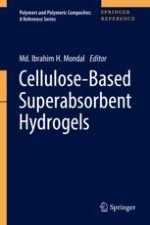Abstract
Lakes, rivers, sea, groundwater, drinking water basins, etc. are the main water sources which can increasingly be polluted by commercial and industrial establishments or human activities. The most existing types of contaminants that pollute these water sources are dye-containing effluents and toxic heavy metals which they affect living being’s life catastrophically. Various methods have been applied to get rid of these kinds of toxic pollutants from water sources such as reverse osmosis, chemical precipitation, membrane filtration, coagulation, ion exchange, electrochemical treatment, and adsorption. Among these methods, adsorption is quite effective and economic method for the removal of toxic pollutants. Hydrogels that can be described as 3D network of hydrophilic polymer chains cross-linked chemically or physically which are able to soak and release a significant amount of water while preserving their network structure from dissolution in aqueous media, and they can be applied in many fields including tissue engineering, drug delivery, wound dressing, food, cosmetics, contact lenses, sensors, and water treatment. Hydrogels are excellent candidate to remove toxic pollutants by adsorption due to their high absorption capacity, porous structure, rich functional groups, and relatively low crystallinity. These hydrogels can be composed of petroleum-derived synthetic polymers, natural occurring materials, or composition of both synthetic and natural materials. Hydrogels that prepared from natural materials are preferred by their low cost and biodegradability and easily available from plenty of resources. To prepare hydrogels, a wide range of synthetic and natural materials have been used, such as cellulose, chitin, and chitosan for natural materials; polyethylene glycol and poly(sodium acrylate) for synthetic materials can be given as an example. Among them, cellulose is a well-known naturally found linear homopolymer having consecutive glucose units connected by glucosidic bond. The use of cellulose-based hydrogels is gaining popularity because of their several advantages such as environmental friendliness, biodegradability, biocompatibility, nontoxicity, easy availability, high abundance, low cost, and thermal and chemical stability for water treatment applications. Therefore, cellulose-based hydrogels have been attracted much attention in both academic and industrial applications including drug delivery, hygiene products, medicine, and water purification technologies. Among these applications, the use of cellulose-based hydrogels for water treatments has been discussed in this chapter.
